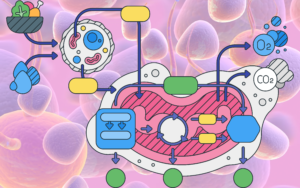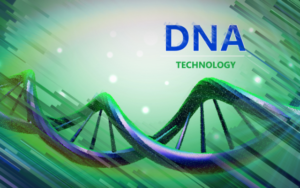Glycolysis is the first stage of cellular respiration, in which a single molecule of glucose is broken down into two molecules of pyruvate. This process occurs in the cytoplasm of the cell and produces a small amount of ATP and two molecules of NADH (nicotinamide adenine dinucleotide).
During glycolysis, glucose is converted into two molecules of pyruvate through a series of enzyme-catalyzed reactions. The process is divided into two phases: an energy-investment phase and an energy-payoff phase. In the energy-investment phase, two ATP molecules are used to phosphorylate glucose, creating a high-energy molecule. In the energy-payoff phase, the high-energy molecule is broken down into pyruvate, releasing energy in the form of ATP and NADH.
Glycolysis is an important process that occurs in all living organisms and produces a small amount of ATP that can be used for various cellular processes. It also produces NADH, which can be used in the next stages of cellular respiration, such as the citric acid cycle and the electron transport chain.
Table of Contents
Location of glycolysis in the cell

Glycolysis occurs in the cytoplasm of the cell, which is the gel-like substance that fills the space between the cell membrane and the nucleus. The cytoplasm is composed of water, dissolved ions, and various organic molecules, including enzymes, which catalyze the reactions of glycolysis.
During glycolysis, enzymes catalyze the breakdown of glucose into pyruvate, and this process occurs in the cytosol, which is the fluid portion of the cytoplasm. This is the same place where most of the metabolic reactions happen in the cell.
It’s worth noting that the process of glycolysis is not limited to one organelle or compartment in the cell. Some of the enzymes involved in glycolysis are located in the cytoplasm, while others are located in the mitochondria.
In summary, glycolysis is a metabolic process that occurs in the cytoplasm of the cell, specifically in the cytosol, where it uses enzymes to catalyze the breakdown of glucose into pyruvate.
Steps of the glycolysis process

The process of glycolysis can be divided into two phases: an energy-investment phase and an energy-payoff phase.
1. Energy-investment phase:
• Glucose is phosphorylated by the enzyme hexokinase (or glucose kinase) with the consumption of one ATP molecule, forming glucose-6-phosphate.
• Glucose-6-phosphate is then converted into fructose-6-phosphate by the enzyme aldolase.
• Fructose-6-phosphate is then phosphorylated by the enzyme phosphofructokinase with the consumption of another ATP molecule, forming fructose-1,6-bisphosphate.
2. Energy-payoff phase:
• Fructose-1,6-bisphosphate is broken down into two molecules of glyceraldehyde-3-phosphate by the enzyme aldolase.
• Glyceraldehyde-3-phosphate is then converted into 1,3-bisphosphoglycerate by the enzyme glyceraldehyde-3-phosphate dehydrogenase.
• 1,3-bisphosphoglycerate is then converted into 3-phosphoglycerate by the enzyme phosphoglycerate kinase, releasing one molecule of ATP.
• 3-phosphoglycerate is then converted into 2-phosphoglycerate by the enzyme phosphoglycerate mutase.
• 2-phosphoglycerate is then converted into pyruvate by the enzyme enolase, releasing one molecule of NADH.
Overall, the process of glycolysis involves a series of enzyme-catalyzed reactions that convert a single molecule of glucose into two molecules of pyruvate. It also produces a small amount of ATP and two molecules of NADH. This process is a net gain of two ATP molecules per glucose molecule and two NADH molecules per glucose molecule.
In summary, the process of glycolysis involves a series of enzyme-catalyzed reactions that convert a single molecule of glucose into two molecules of pyruvate. It also produces a small amount of ATP and two molecules of NADH. This process is a net gain of two ATP molecules per glucose molecule and two NADH molecules per glucose molecule.
It’s important to note that glycolysis is not only the first stage of cellular respiration but also a standalone process that can happen in many organisms independently. In some organisms, such as yeast and bacteria, glycolysis is the only means of obtaining energy. This process is called anaerobic respiration, it does not require oxygen and produces a small amount of ATP and small amounts of lactic acid or ethanol.
Glycolysis also plays an important role in the metabolism of glucose, as it is the first step in the breakdown of glucose for energy production. Additionally, the intermediates produced during glycolysis are also used in other metabolic pathways, such as the synthesis of amino acids and nucleotides.
Finally, it’s also worth mentioning that the process of glycolysis is not limited to glucose, it can also happen with other sugars such as fructose and galactose. These sugars also will be converted into pyruvate by the same process, but the intermediates are different, and the enzymes involved are specific to each sugar.
In conclusion, glycolysis is a fundamental metabolic process that plays an essential role in the energy metabolism of all living organisms. It’s the first stage of cellular respiration and also a standalone process that can happen independently. It’s also a process that can happen with other sugars and anaerobic respiration. The intermediates produced in this process are also used in other metabolic pathways.
Another important aspect of glycolysis is its regulation. The process of glycolysis is tightly regulated to ensure that glucose is broken down in a controlled manner, as a rapid or excessive breakdown of glucose can lead to metabolic imbalances.
One way that glycolysis is regulated is through the use of allosteric enzymes. Allosteric enzymes have specific binding sites that can be occupied by molecules called allosteric regulators. These regulators can either activate or inhibit the enzyme, depending on the concentration of the allosteric regulator.
For example, the enzyme hexokinase, which is responsible for phosphorylating glucose at the beginning of glycolysis, is inhibited by glucose-6-phosphate. This means that as the concentration of glucose-6-phosphate increases, the activity of hexokinase decreases, slowing down the rate of glycolysis.
Another example is the enzyme phosphofructokinase, which is responsible for converting fructose-6-phosphate into fructose-1,6-bisphosphate. This enzyme is activated by AMP (adenosine monophosphate) and inhibited by ATP (adenosine triphosphate). This means that when the energy levels of the cell are high, the activity of phosphofructokinase decreases, slowing down the rate of glycolysis.
In addition to allosteric regulation, glycolysis is also regulated by hormones and other signaling molecules. For example, insulin stimulates the activity of hexokinase, promoting the uptake and metabolism of glucose, while glucagon promotes the breakdown of glycogen to glucose, thus stimulating the activity of glycolysis.
In summary, glycolysis is a highly regulated process, controlled by allosteric enzymes, hormones, and other signaling molecules. This regulation ensures that glucose is broken down in a controlled manner, avoiding metabolic imbalances and providing the appropriate amount of energy for the cell’s needs.
gross and net gain of ATP during glycolysis

During the process of glycolysis, a single molecule of glucose is broken down into two molecules of pyruvate. This process also produces a small amount of ATP and two molecules of NADH (nicotinamide adenine dinucleotide).
The gross gain of ATP during glycolysis is 4 ATP molecules. This is because two ATP molecules are consumed during the energy-investment phase to phosphorylate glucose, and two ATP molecules are produced during the energy-payoff phase by substrate-level phosphorylation.
However, the net gain of ATP during glycolysis is 2 ATP molecules per glucose molecule. This is because two ATP molecules are consumed during the energy-investment phase and two ATP molecules are produced during the energy-payoff phase. This means that for each molecule of glucose that enters glycolysis, two ATP molecules are produced.
It’s worth mentioning that the net gain of ATP during glycolysis can vary depending on the organism and the conditions of the cell, as the amount of ATP produced during substrate-level phosphorylation can vary. Also, the NADH produced during glycolysis can be used in the next stages of cellular respiration, such as the citric acid cycle and the electron transport chain, to generate more ATP, thus increasing the overall gain of ATP.




